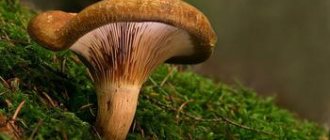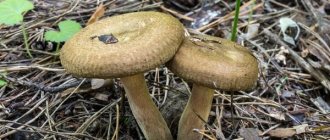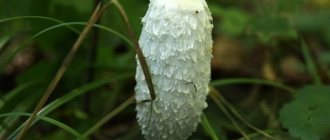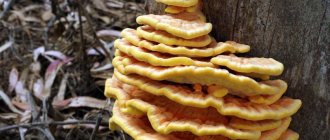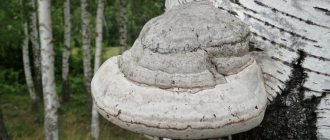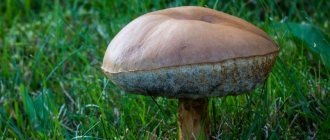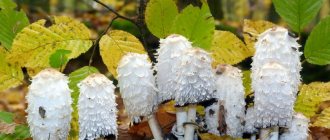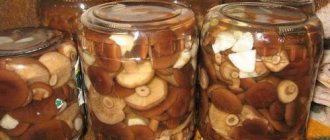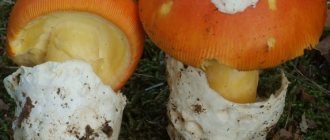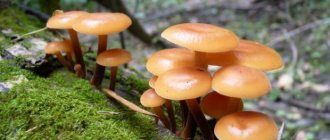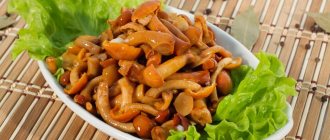In this article you will find detailed information about what pig mushroom looks like and what other names there are for the barnyard mushroom. Is it recommended to eat cow's lip, how to properly prepare mushrooms, what to do if symptoms of mushroom poisoning appear?
The barnyard mushroom was previously considered edible, and even now not everyone believes that it can cause poisoning. Already at the end of the last century, after mass poisonings, scientists conducted a number of investigations. As a result, it was found that the pig causes autoimmune reactions.
Therefore, cow's lip is classified as a poisonous mushroom. It is not that safe to eat. Poisons can accumulate in the body, to be more precise - muscarine. There is not so much of it in the product; after several uses of the product in food there will be no changes. Poisoning occurs as a result of the accumulation of a substance.
What is a barn mushroom
An interesting fact is that this mushroom was previously considered edible, and only over the last 35 years has it moved into the category of conditionally edible. Yes, thanks to modern advances in science, we know two reasons why pigs are no longer considered edible (Figure 1).
Note: It is known that barns contain muscarine, which is also found in fly agarics, but not in such concentration.
It also contains lectin, which is dangerous for humans, but only at high concentrations in the body. But it’s unlikely that anyone will eat only pigs for more than one day.
Figure 1. Mushroom pickers are still debating the edibility of the barnyard.
Overall, when consumed in moderation and properly prepared, this mushroom is very healthy. It contains antioxidants, plant protein, and is low in calories. A more detailed description is given below.
How to choose quality barns
The dish will be tasty and healthy if you use fresh and preferably young mushrooms for its preparation. The quality of a barn can be determined by the following characteristics:
- The hat should be slightly convex with the edges turned up - this is a sign of young pigs. In more mature specimens it is funnel-shaped.
- If the mushroom is fresh, then its cap is dense, fleshy, but in no case flaccid. Its shade should be brownish-olive. This indicates that the pig is young. If the color is dark brown, it means the mushroom is old; dark spots appear on it when pressed.
- The cowshed has almost no characteristic mushroom aroma. If you smell any foreign odor, it is better not to take such specimens.
- Do not buy pigs with wormholes on the cut of the leg. True, if there are few traces of parasites, the product can be used, because in the future it still needs to be soaked.
It is not difficult to choose high-quality fresh cow mushrooms, because these mushrooms do not last long after picking, they quickly begin to mold and darken, and this is easy to notice with the naked eye.
Description and photo
Mullein belongs to the pig family. You won’t confuse it with others, because it is quite large, the cap can be up to 15-18 cm in diameter, so “big”! I collected five pieces, and the bucket is full.
The pig's hat is dense, plates grow on the underside, the edges can be different: wavy, straight, ribbed. The leg is low, grayish or yellowish in color. The color of “youth” is light gray, slightly greenish or brown, while that of “retirees” is dark brown (Figure 2).
Cleaning and preparing barns
Preparing pigs for further use in cooking and winter seaming comes down to three stages: cleaning, soaking and boiling. Let's take a closer look at each one.
Cleaning
Cowweed is a fairly large mushroom (the diameter of the cap can reach up to 15 cm), so it is very convenient to process and it is done quickly.
First, remove any sticky twigs and leaves. Then use a soft brush to go over the entire mushroom, paying special attention to the plates. There is no need to remove the skin from the cap.
Cut off the tip of the stem of each specimen. A lot of dust and dirt always accumulate on it, and there is no point in cleaning this part. Easier to remove.
Rinse the mushrooms under running water. Now the pigs are ready for the second stage.
Soaking
It is performed in three passes. This must be done in a saline solution. Measure out enough cold water to completely submerge the pigs, and add salt to it at the rate of 20 g per liter. Immerse the mushrooms in the solution and leave for 5 hours.
After this, change the fluid 2 more times. In total, barns must remain in salt water for 15 hours. After this, rinse them under running water and you can begin cooking.
Cooking
Like soaking, it also takes place in three stages. Fill the pan with cold water again and add salt to it. Only now you will need 10 g per liter. Place the mushrooms in a bowl, put on the fire and bring to a boil.
When the water begins to bubble, cook for 5 minutes and strain the cows through a colander. Fill them with the same saline solution, but now from the moment of boiling, cook for half an hour.
Drain the liquid again, add fresh liquid and cook for 40 minutes. Place the pork in a colander, let it drain, and place the boiled mushrooms on a paper towel to dry.
Now you can cook anything from cowsheds: salt, roll with vinegar or fry. Now we’ll tell you how to do it efficiently and tasty.
Places of distribution and timing of fruiting
Cowweed, or pigweed, is a summer mushroom; it can be collected from early summer until late autumn. One of its subspecies loves sunny meadows. Others, on the contrary, grow in the shade and on tree trunks (Figure 3).
Figure 3. These mushrooms can grow under coniferous and deciduous trees
They can be found both in coniferous and mixed forests. The barn also does not disdain places near the road, with forest belts. It grows in small families and whole groups, but not alone.
Considering that fruiting bodies can accumulate toxic substances, it would be correct to collect barns not near roads or industrial facilities, but in the depths of the forest.
Fried cows with sour cream
Ingredients: five hundred grams of young mushrooms, half a glass of sour cream, as well as hard cheese, garlic, onions, parsley and basil, apples, salt and spices to taste, vegetable oil or pork fat.
Preparation
Before cooking barnyard mushrooms, they should be cleaned and boiled. Then they are washed and cut into pieces. Place cowsheds in a heated frying pan in fat or vegetable oil and fry them for fifteen minutes, avoiding overdrying. Next, add onions and seasonings, but do this sparingly to preserve the mushroom flavor and aroma. Mushrooms should be salted at the end of frying, but before that, sour cream is added to them. Then the dish is simmered until fully cooked. If more sauce is required, dilute the sour cream with milk or mushroom broth. The dish can be served either hot or cold.
Beneficial features
Cowweed is beneficial only when consumed in moderation. The lectin contained in the pulp, when excessively accumulated in the body, becomes dangerous to human health.
In addition to lectin, pork contains antioxidants, which are a good preventive measure against cancer. This mushroom also contains protein, the concentration of which is greater than in meat and legumes.
Dishes from the barn are very varied. It is good fried, pickled and salted. You can also start preparing food for the winter, and then during the cold season you will always have the opportunity to diversify your diet with delicious dishes.
Omelet with cowsheds
Ingredients: one glass of boiled mushrooms, one onion, four eggs, two tablespoons of butter, one fourth of sweet pepper, herbs, salt and spices to taste.
Preparation
Chop the onion and fry until it becomes transparent. Then pre-boiled and chopped mushrooms are added to it and fried for ten minutes over low heat, adding salt and pepper. As a result, you will have very appetizing barns (photo). Combine the mushrooms with beaten eggs and fry for another 5-7 minutes. Top everything with chopped bell pepper and chopped herbs. The dish is ready!
Harm and contraindications
We have already described a little the dangers associated with barns, although they are not considered poisonous. But we can remind ourselves of three features of this mushroom, which logically explain its benefits and harms (Figure 4).
Firstly, it contains muscarine, which becomes safe if you soak and boil the crop according to the scheme indicated below.
Secondly, the pulp contains lectin, which is dangerous for humans in large quantities. Therefore, eat pigs in moderation.
Figure 4. The pulp contains dangerous toxic substances, which are partially removed only after repeated soaking and cooking
Thirdly, like any mushrooms, pigs are sorbents. Therefore, those that grow near the highway, factories and other industrial production will definitely be dangerous, even if you are not mistaken in the view. Even if you carefully scrub the surface of the cap and clean it, toxic substances will remain in the pulp and pose a danger.
And fourthly, children under 6 years old do not produce enzymes to digest any mushrooms. Therefore, they will develop poisoning even after eating such popular mushrooms as champignons.
Fried cowsheds with potatoes
Ingredients: eight mushrooms, eight potatoes, one onion, half a spoon of black pepper, thirty grams of vegetable oil, salt to taste.
Preparation
Before cooking barnyard mushrooms, they are boiled twice in salted water. To do this, the mushrooms are cleaned, washed and cut into medium-sized pieces, poured with water and cooked for twenty-five minutes. Then the cowsheds are placed in a colander and thoroughly washed with cold water, and again set to cook for twenty-five minutes. Then the mushrooms are washed and dried, placed in a frying pan, where vegetable oil is first poured, and heated until the excess liquid boils away. Then add chopped onion and fry for ten minutes, after which add chopped potatoes. Fry everything until the potatoes are ready, until golden brown, stirring occasionally.
Safe recipes
Svinushki are mostly prepared marinated or salted. But no matter what recipe you choose, you need to secure them first.
Note: Processing begins with cleaning. There is no need to remove the skin from the cap from the barn, but it is worth cleaning thoroughly of debris and sand, especially between the plates on the inside. You can use a soft brush or sponge. Rinse several times in running water.
Soaking and triple boiling will help get rid of toxins and muscarine:
- Soak the mushrooms three times in a well-salted solution. Leave for at least 5 hours each time.
- Boil them in salt water three times too. Take about a teaspoon of salt per kilogram of raw materials. The first time you need to cook after boiling for 5 minutes, the second time - 30 minutes, and the third - 45 minutes. Each time fill the product with cold water, not boiling water. When changing the water, rinse the mushrooms well.
- Do not think that young specimens need to be cooked less, this is a mistaken opinion. In addition to the waiting time, you can determine readiness by “immersion” in the pan. “Submariners” are ready-made mushrooms, and those that float on top are not yet cooked.
After it has cooled, you can start working on your pickling and pickling recipes. They can also be used in salads or as a side dish. You can freeze it this way and store it for six months. But the main thing to remember is that the barn cannot be used without first soaking and triple boiling! Is it dangerous! That's why pigs are not dried.
Figure 5. Cowweed is usually pickled and salted, but it is also good fried.
So, a few popular recipes. Pickled pigs are considered popular: prepare the marinade. For a liter of water, put: 40 grams of salt, 20 grams of sugar, peppercorns, dill umbrellas, bay leaf. After the marinade boils, throw in the mushrooms (three kilograms), let it boil again and cook for 15 minutes. After this, pass them through a colander, but leave the marinade in a separate bowl. Let the mushrooms dry a little and place tightly in sterile jars. Put the marinade back on the fire, add 20 ml of vinegar essence (70%) and after boiling, pour the marinade over the mushrooms, having previously selected the dill and bay leaf umbrellas, and roll up the jars tightly (Figure 5).
Salted pigs are another popular delicacy. This recipe is suitable for those who have a good cellar or a spacious refrigerator. In this form, the workpiece can be stored at a temperature not exceeding +10°C.
Let's start cooking:
- For pickling you will need enamel or wooden utensils. It is important that the enamel in the pan is not damaged.
- Cut the stems off the cooked mushrooms. Only hats or small pigs are suitable for us. The legs can be used for other purposes, for example, for freezing or frying with potatoes.
- Wash and dry currant, horseradish, cherry leaves, and dill umbrellas. Peel and cut the garlic into slices.
- We will salt the mushrooms in layers. Place salt on the bottom of the vessel, then a layer of mushrooms about five centimeters, then again salt and our herbs with garlic, then again a layer of mushrooms and so on.
- The topmost layer will be salt. Calculate total salt: 120 grams per 3 kg of barns.
- Cover everything with clean, ironed gauze and place it under a press in a cool, dark place for two weeks. We change the gauze every other day. Then we put the pigs into sterile jars, fill them with brine from the tubs and close them with nylon lids.
- In this form, barns can be stored for 4-6 months in the refrigerator or in the cellar. If, when opening such a jar, you notice a suspicious odor or a moldy film on top, then it is better not to risk your health and not consume such a product.
There are quite a lot of recipes and after the preliminary processing described in this article, you can prepare them at your discretion. Fried mushrooms are used, for example, to prepare soups and side dishes.
When boiled, they are suitable for salads. Due to their meatiness, they are very tasty with sour cream sauce or in julienne.
Pickled cowsheds
Ingredients: half a glass of table vinegar, two tablespoons of salt, ten cloves of garlic, five stalks of dill, two bay leaves, as well as five black peppercorns, two spoons of sugar, a pinch of cinnamon.
Preparation
Before cooking barnyard mushrooms, you need to soak, wash and cook them. Boil in salted water for about twenty-five minutes, periodically removing any foam that appears. After this, remove the mushrooms from the heat and cool. Place the pigs into jars prepared in advance, pour in the cooled marinade, add two tablespoons of sunflower oil and roll up.
Substrate for mycelium
To obtain Pink Buffalo mycelium, growers sow a spore suspension onto various types of substrate. The strain colonizes wheat and oats well, as well as rice cakes and pasteurized manure mixed with straw.
For quick colonization, it is also recommended to use roasted pearl barley or canary seed.
Reference! The grain for inoculation with a spore suspension must first be disinfected. To do this, add an antibiotic or hydrogen peroxide when soaking the grain. If you plan to sterilize the mycelium substrate using a microwave oven, then you do not need to use these products.
In order for the mushrooms to increase their psychoactivity, as well as to increase the nutrients in the substrate, you can add a certain amount of horse manure granules when cooking grain. This additive is practically devoid of the “aromatic” properties of manure, but some odor cannot be avoided
Reference! After cooking, the grain should dry out a little. If the substrate in the jars is too wet, it can turn sour and all the grower’s work will go down the drain.
Description of the barnyard mushroom - thin pigweed, symptoms of poisoning
With the development of microbiology, the attitude towards some mushrooms has been revised. Thus, the well-known cow mushroom, also known as the thin pig mushroom, was considered conditionally edible for a long time. Moreover, many mushroom pickers positively assessed its taste and collected it with pleasure. At the moment, the attitude has changed dramatically.
Description
The thin pigweed (Paxillus involutus) belongs to the class Agaricomycetes, family Svinushkovye, genus pigweed, poisonous. This mushroom is called differently, the most common name being barn mushrooms. But you can also hear such as: pig, pig or pig, filly, dunka, pig's ear, etc. All names are associated with appearance.
- The pig's hat is smooth, with a velvety, rolled, drooping edge, with a diameter of 5 to 15 cm, fleshy, round in shape with a depressed cent. The color of the cap is brown-olive in young mushrooms, rusty-brown or gray-brown in adults. The surface is pleasant to the touch, dry, smooth. At high humidity it is sticky.
- The plates go slightly down the stem, yellowish, close together. Turn brown when pressed.
- The pulp is dense and soft. Color – from light yellow to yellowish brown. It darkens when cut or pressed. It has no special smell.
- The stem is the same color as the cap or a little lighter, short from 3 to 9 cm, not thick, from 0.6 to 2 cm in diameter, widens towards the base of the cap. The surface is matte, without velvety pubescence.
The barnyard mushroom is most often confused with Chanterelles. They are similar only in the structure of the stem, the shape and color of the caps, but they differ in texture (in chanterelles it is fleecy).
Places of distribution and fruiting period
The thin pig prefers to live in deciduous or coniferous forests, gardens, and parks. Of the deciduous trees, he prefers birch. At the same time, the mushroom selects young undergrowth along the outskirts of swamps, clearings, and ravines. Sometimes it grows on the trunks of fallen trees. More often found on moist soil in shady places.
Pig mushrooms are found in almost all climatic zones. They are distinguished by great endurance, and even in dry years, when there are practically no other mushrooms, they seduce lovers of “quiet hunting”.
They germinate most massively from June to October. At the same time, they settle in groups (fruit abundantly and amicably). It is very rare to find a solitary mushroom.
As a rule, if you come across one, his “comrades” are somewhere nearby.
| Paxillus involutus (Batsch) Fr., 1838 Thin pig (lat. Paxillus involutus) - a mushroom of the pig family. Previously, this mushroom was considered conditionally edible, but is now classified as deadly poisonous.
Description [edit | edit code ]The cap is up to 12-15 cm in diameter, rarely up to 20 cm. Fleshy, at first slightly convex with a rolled felt edge, then flat, funnel-shaped in the middle, very rarely funnel-shaped. The edge is drooping, frilled or straight ribbed, often wavy. The cap of a young mushroom is olive-brown (olive-brown), while that of adults is gray-brown to rusty-brown. It darkens when pressed and when cut. The surface is dry to the touch, fibrous-fluffy in young mushrooms and smoother in adult mushrooms; in damp weather it is shiny and sticky. The pulp is dense, soft, later loose. The color ranges from pale yellow to brownish or yellowish-brown, darkening when cut. Often, especially in dry weather, wormy. Without any special smell or taste. The hymenophore is descending, folded, and is often described as lamellar, although it is more correct to call it pseudoplate. The folded layer, unlike real plates, can be separated from the lower surface of the cap. The pseudoplates are yellowish-brown to rusty-brown in color, lighter than the cap, and darken when pressed. The leg is solid, short, up to 9 cm long and up to 2 cm in diameter. The surface of the leg is matte, smooth, ocher-olive or dirty yellow, lighter than the cap or almost the same color as it. Ecology and distribution [ edit | edit code ]The mushroom grows in forests of various types, most often in damp, shady places, sometimes even on tree trunks. Svinushka is found in groups, less often singly. Occurs in large numbers from June to October. Fruits frequently and annually. Poisonous properties [edit | edit code ]The toxicity of the pig was first noted in October 1944: the German mycologist Julius Schaeffer, after eating pigs, felt unwell (vomiting, diarrhea, and fever developed) and died 17 days later from acute renal failure [2] [3]. Nevertheless, the attitude of doctors in different countries towards svinushka remained different for several decades: in some European countries, svinushka was considered a deadly mushroom, and in the USSR (until 1981) it was allowed to be harvested [4]. In 1981, a ten-year study of cases of pig poisoning was completed in Poland, which showed the following: in 93 of 109 cases of pig poisoning, patients were hospitalized, and three people died [5]. Currently, the mushroom is considered poisonous, although the symptoms of poisoning do not always appear and/or not immediately. Deaths have occurred among those who eat pork [6]. The fact is that pork contains toxins (lectins) that are not destroyed when boiled, despite the fact that some mushroom pickers boil pork more than once. [7]
Some time after consumption, the fungal antigen triggers an immune response consisting of the production of antibodies that can damage cells whose membranes contain pigweed antigens [9] . The destruction of red blood cells by antibodies causes hemolytic anemia and, as a consequence, nephropathy and renal failure due to damage to the renal glomeruli by fragments of destroyed red blood cells. Since it takes a certain time for the production of antibodies, the autoimmune reaction is most pronounced in people who have repeatedly consumed pork, especially if they have previously experienced gastrointestinal disorders after such food. [10] People's sensitivity to mushroom toxins varies greatly, but children are especially sensitive.
The Ministry of Health of the USSR, approving the “Sanitary Rules for the Procurement, Processing and Sale of Mushrooms” in June 1981, excluded thin and also thick pork from the list of mushrooms permitted for procurement. In 1984, at the direction of the Deputy Chief Sanitary Doctor of the USSR, the thin mushroom was finally included in the list of poisonous mushrooms. [12] In 1993, by a decree of the State Committee for Sanitary and Epidemiological Supervision of the Russian Federation, the thin mushroom was included in the list of poisonous and inedible mushrooms. [13] The Ministry of Health of Ukraine also banned the collection and consumption of pigs [8] . Symptoms of poisoning [edit | edit code ]When consuming pork for the first time, as a rule, no acute symptoms of poisoning are observed [14]. However, repeated consumption of pork leads to a fatal danger [15]. The gastrointestinal symptoms of poisoning develop most quickly: vomiting, diarrhea, abdominal pain, while the volume of circulating blood decreases. [16] Soon after, symptoms of intravascular hemolysis come to the fore: pallor, jaundice, decreased urine output, increased hemoglobin levels in the urine, or, in severe cases, oligoanuria. Medical laboratory tests show erythropenia, increased indirect bilirubin and free hemoglobin, and a decrease in haptoglobin. Hemolysis can lead to numerous complications, including acute renal failure, shock, acute respiratory failure, and disseminated intravascular coagulation. [10] [17] [18] Treatment [edit | edit code ]There is no antidote. Antihistamines are used to reduce the severity of the autoimmune reaction. Supportive treatment includes monitoring of blood counts, renal function, blood pressure and fluid and electrolyte balance and correction of abnormalities. [19] The use of corticosteroids may be a useful adjunct to treatment as they protect blood cells from hemolysis, thereby reducing complications. [20] Plasmapheresis is useful to remove antibodies from the blood. [21] Hemodialysis is used to treat kidney failure. |
Signs of poisoning and first aid
The cowshed is quite insidious. When the concentration of poisons in the body reaches critical values (and this can happen after several years), classic symptoms of food poisoning develop. Diarrhea, vomiting, and abdominal pain appear. But at the same time, the volume of blood circulating in the vessels decreases.
After some time, the symptoms of poisoning are replaced by pallor, a decrease in the volume of urine and the appearance of blood impurities in it. Red blood cells begin to break down, which leads to numerous complications, including kidney and respiratory failure.
Providing first aid yourself will only worsen the condition. You need to immediately contact a medical facility. Moreover, even if a medical examination reveals the true cause of the disease, there are no antidotes. Therefore, symptomatic treatment is used, aimed at removing antibodies and compensating for renal failure. Treatment is quite effective and deaths are uncommon. But the poison remains in the body. And along with it - the consequences of poisoning (for example, the need to regularly undergo hemodialysis).
Even if friends claim that thin pig is a tasty and completely safe mushroom, you should not try it. Its taste can only be enjoyed a limited number of times. And the consequences will remain with you forever.
